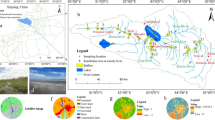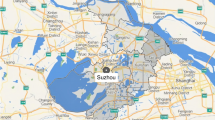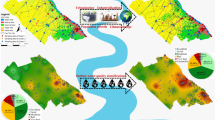Abstract
China’s rapid social and economic development has led to a significant deterioration in the water environment, which has limited sustainable regional development. Therefore, understanding the specific factors that affect the water environment is vital for future water conservation efforts. From a social economy perspective, this paper used population, the economy, urbanization, technological level, water consumption, and other factors to expand the STIRPAT model, after which partial least squares was applied to solve the model parameters and comprehensively analyze the impact of regional development on the water environment in Sichuan Province from 2007 to 2017. It was found that the main factors affecting the water environment were resident population, urbanization, service industry development, and industrialization, with the industrialization factor being found to have a reverse waste-sewage water discharge inhibition. In addition, it was found that during the study period, there was no environmental Kuznets curve between water resource environmental pollution and economic growth in Sichuan Province. Finally, some policy recommendations for improving the water environment were given based on the results.





Similar content being viewed by others
References
Al-Mulali U, Ozturk I (2015) The effect of energy consumption, urbanization, trade openness, industrial output, and the political stability on the environmental degradation in the MENA (Middle East and North African) region. Energy 84:382–389
Al-mulali U, Sab CNBC, Fereidouni HG (2012) Exploring the bi-directional long run relationship between urbanization, energy consumption, and carbon dioxide emission. Energy 46:156–167
Chen J, Huang K, Yu Y, Zhang Y (2016a) Analysis of influencing factors of water footprint based on the STIRPAT model: evidence from the Beijing agricultural sector. Water 8:513
Chen KL, Liu XQ, Lei D, Huang GZ, Li ZG (2016b) Spatial characteristics and driving factors of provincial wastewater discharge in China. Int J Environ Res Public Health 13:1221
Cui H, Wu R, Zhao T (2018) Decomposition and forecasting of CO2 emissions in China’s power sector based on STIRPAT model with selected PLS model and a novel hybrid PLS-Grey-Markov model. Energies 11:2985
Dietz T, Rosa E (1994) Rethinking the environmental impacts of population, affluence and technology. Hum Ecol Rev 1:277–300
Dietz T, Rosa EA (1997) Effects of population and affluence on CO2 emissions. Proc Natl Acad Sci U S A 94:175–179
Ehrlich PR, Holdren JP (1971) Impact of population growth. Science 171:1212–1217
Guo WH, Zhou YZ, Kan XL (2015) Characteristics and driving factors of wastewater emissions in guangdong province from 1990 to 2012—a study based on STIRPAT model and decoupling index. J Irrig Drain 34:7–10
Habidin NF, Hibadullah SN, Mohd Fuzi N, Salleh MI, Md Latip NA (2018) Lean manufacturing practices, ISO 14001, and environmental performance in Malaysian automotive suppliers. Int J Manag Sci Eng Manag 13:45–53
Han B, D. W, Deng WN, Han L (2016a) Effect of information and communication technology on energy consumption in China. Nat Hazards 84:297–315
Han D, Currell MJ, Cao G (2016b) Deep challenges for China’s war on water pollution. Environ Pollut 218:1222–1233
Hu JX, Guan H (2018) Research on driving factors of wastewater discharge based on the STIRPAT model and Tapio decoupling model:a case in Chongqing. Environ Pollut Control 3:24
Jaleel F, Daim T, Giadedi A (2019) Exploring the impact of knowledge management (KM) best practices for project management maturity models on the project management capability of organizations. Int J Manag Sci Eng Manag 14:47–52
Jin ST, Shi PJ, Bo LI, Wei W (2013) Developing model of Wuwei City under the control of water resources with the STIRPAT model. Arid Land Geography 36:875–882
Lei HJ, Xia XF, Li CJ, Xi BD (2012) Decomposition analysis of wastewater pollutant discharges in industrial sectors of China (2001-2009) using the LMDI I Method. Int J Environ Res Public Health 9:2226–2240
Li CM, Fu CH (2016) The dynamic stability of relationships between population size and waste water emissions. Resourc Sci 38:1169–1178
Li K, Lin B (2015) Impacts of urbanization and industrialization on energy consumption/CO2 emissions: does the level of development matter? Renew Sust Energ Rev 52:1107–1122
Liddle B, Lung S (2014) Might electricity consumption cause urbanization instead? Evidence from heterogeneous panel long-run causality tests. Glob Environ Chang 24:42–51
Ma Z, Liu W, L. W, Ma PL, Wang YX, Dong DM, Duan HY, Wang XE (2013) Study on energy consumption prediction and energy management in Jilin Province based on STIRPAT model. Appl Mech Mater 281:542–545
Nobari A, Kheirkhah A, Esmaeili M (2019) Considering chain-to-chain competition on environmental and social concerns in a supply chain network design problem. Int J Manag Sci Eng Manag 14:33–46
Ocampo L (2018) A probabilistic fuzzy analytic network process approach (PROFUZANP) in formulating sustainable manufacturing strategy infrastructural decisions under firm size influence. Int J Manag Sci Eng Manag 13:158–174
Rosa EA (2003) STIRPAT, IPAT and ImPACT: analytic tools for unpacking the driving forces of environmental impacts. Ecol Econ 46:351–365
Shahbaz M, Chaudhary AR, Ozturk I (2017) Does urbanization cause increasing energy demand in Pakistan? Empirical evidence from STIRPAT model. Energy 122:83–93
Srebotnjak T, Carr G, Sherbinin AD, Rickwood C (2012) A global water quality index and hot-deck imputation of missing data ☆. Ecol Indic 17:108–119
Su SL, Rui X, Mi XY, Xu XY, Zhang ZH, Wu JP (2013) Spatial determinants of hazardous chemicals in surface water of Qiantang River, China. Ecol Indic 24:375–381
Wang HW (1999) Partial least squares regression method and application. National Defend Industry Press, Beijing
Wang X (2015) Impacts of social and economic factors on water environment pressure in Beijing based on STIRPAT model. Environ Sci Technol 38:48–52
Wang HW, Wu ZB, Meng J (2006) Partial least squares regression-linear and nonlinear methods. National Defend Industry Press, Beijing
Wang Y, Chen J, Lu G (2011a) Temporal causal relationship between resource use and economic growth in East China. China World Econ 19:93–108
Wang Y, Wang Y, Zhou J, Zhu X, Lu G (2011b) Energy consumption and economic growth in China: a multivariate causality test. Energy Policy 39:4399–4406
Wang Y, Zhang X, Kubota J, Zhu X, Lu G (2015) A semi-parametric panel data analysis on the urbanization-carbon emissions nexus for OECD countries. Renew Sust Energ Rev 48:704–709
Wang Y, Han R, Kubota J (2016a) Is there an environmental Kuznets curve for SO2 emissions? A semi-parametric panel data analysis for China. Renew Sust Energ Rev 54:1182–1188
Wang Y, Li L, Kubota J, Han R, Zhu X, Lu G (2016b) Does urbanization lead to more carbon emission? Evidence from a panel of BRICS countries. Appl Energy 168:375–380
Wang Y, Yang G, Dong Y, Cheng Y, Shang P (2018) The scale, structure and influencing factors of total carbon emissions from households in 30 provinces of China—based on the extended STIRPAT model. Energies 11:1125
Xiao Q, Gao Y, Hu D, Tan H, Wang TX (2011) Assessment of the interactions between economic growth and industrial wastewater discharges using co-integration analysis: a case dtudy for China’s Hunan Province. Int J Environ Res Public Health 8:2937
Xie H, Ye G, Xie Y (2004):Quantitative analysis of the effects of industrial structure change on the industrial waste drainage[J]. Journal of Fujian Normal University (Natural Science Edition),20(4): 90-93.
Yang L, Xia H, Zhang X, Yuan S (2018) What matters for carbon emissions in regional sectors? A China study of extended STIRPAT model. J Clean Prod 180:595–602
Yang J, Su J, Song L (2019) Selection of manufacturing enterprise innovation design Project based on consumer’s green preferences. Sustainability 11:1375
Yong G, Wang ML, Sarkis J, Bing X, Lin Z, Fujita T, Yu XM, Ren WX, Zhang LM, Dong HJ (2014) Spatial-temporal patterns and driving factors for industrial wastewater emission in China. J Clean Prod 76:116–124
Yuan W, Chen Z, Lu A, Li L, He Y, Tojo J, Zhu X (2017) A disaggregated analysis of the environmental Kuznets curve for industrial CO2 emissions in China. Appl Energy 190:172–180
Zhang HX, Guo JL, Zhu JY (2002) Muitivariate data analysis methods and applications with few observations. Northwestern Polytechnical University Press, Xi’an
Zhang C, Wang Y, Song X, Kubota J, He Y, Tojo J, Zhu X (2017) An integrated specification for the nexus of water pollution and economic growth in China: panel cointegration, long-run causality and environmental Kuznets curve. Sci Total Environ 609:319–328
Zhao C, Chen B, Hayat T, Alsaedi A, Ahmad B (2014) Driving force analysis of water footprint change based on extended STIRPAT model: evidence from the Chinese agricultural sector. Ecol Indic 47:43–49
Zhou J, Yang GS (2007) Study on the evolvement of the relationship between industrial wastewater discharge and economic growth in Jiangsu Province. Geogr Res 26:931–939
Author information
Authors and Affiliations
Corresponding author
Additional information
Responsible editor: Marcus Schulz
Publisher’s note
Springer Nature remains neutral with regard to jurisdictional claims in published maps and institutional affiliations.
Rights and permissions
About this article
Cite this article
Liang, X., Gong, Q., Zheng, H. et al. Examining the impact factors of the water environment using the extended STIRPAT model: A Case Study in Sichuan. Environ Sci Pollut Res 27, 12942–12952 (2020). https://doi.org/10.1007/s11356-019-06745-z
Received:
Accepted:
Published:
Issue Date:
DOI: https://doi.org/10.1007/s11356-019-06745-z




